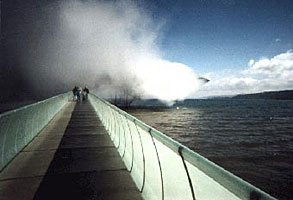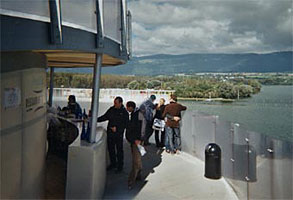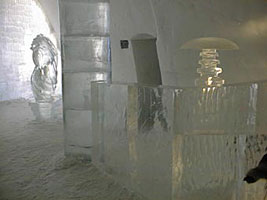Water and structures.
Swiss Expo's Nuage sculptural lake structure and the North Sweden's Ice Hotel

Along the coastal road close to where I live, a cloud sits, where the edge of the sea and land mass meet. It envelops the cliffs, the shoreline path and accompanying road, so that, looking up all that can be seen is a sunny haze out the other side. No one appeared to be giving neither much thought or much concern, it was one of those beta level natural phenomena which the human species travel through neither giving much thought or concern, less attention grabbing than the wind in the trees of a force nine gale or a beautiful deep red and ochre sunset, or for that matter, a very clear rainbow.
The cloud rolling around its cliff top perch brought back memories of a visit in autumn 2002, to Switzerland's Expo 02, and its big highlight set-piece, an oddity, even freak of nature, the somewhat baffling structure Nuage, or Blur Nuage extended calmly out into the western tip of Lac de Neuchatel beside an urban town's lakeside space usually reserved for gentle walks and evening promenades by the residents of Nuage's host town, Yver De La Bains.
Yves De La Bains is one of four towns in Switzerland's comparatively lesser-known Three Lakes region, an hour or so north of Geneva. Together the four towns acted as a split or distributed site for the first Swiss Expo for fifty years. Each town had been provided with huge, attention grabbing and visually arresting buildings and sculptural structures for visitors from near and far to come to gawp at, and wander around, either within, through, or usually, under. Up the railway line was Neuchatel itself, with a wooden spherical dome, home to the Expo's rather Spartan environmental contribution, plus, floating at the shoreline a series of massive pod shelters, host to a variety of exhibits. Further north still was the Bienne installation, this time hugging BielerSee shoreline, a vast atrium, with open roofing towering over the ground-space, housing sound galleries framed within timber gantried nose cones, accessed at one end by a long slithering pencil thin bridge which took twenty minutes to walk across. Actually sitting in the midst of the third lake, Lac de Moriat, offshore from the fourth of Expo's chosen towns, Murten Morat, French starchitect Jean Nouvel had created a floating steel hulk, a ruddy metallically rusted red cube, to be approached and landed on by boat. Nouvel, yet another architectural man in black, stands at the deconstructionist theoryhead end of modern architectural in romance France.
There was something Post Modern about EXPO.02, not only the sharp angularity, and blitz of bright colours adorning many of the buildings, but the fact these were temporary structures, reflecting the spectacular but replaceable razzle-dazzle aesthetic of so much Post Modern Architecture of the last decade. It would all be gone once the Expo circus left town. As to Nouvel, he is a known quantity in Switzerland. Another, this time, permanent, building, the recent City and Cultural Hall, in Luzern announces itself brazenly. The hall is another part of where the Post Modern turn in architecture can find itself; the buildings impregnable fortress-factory of steel lattice work.
If public and professional visitors were whetting their appetites on Nouvel's rust riven lake cube, or Bienne's futuristic pods it was Yverdan's strange floating apparition which led the pack, and really caught the eye of both public and press alike, at home and abroad, at this, the sixth Swiss National Expo. In a round up of the year in architecture, the man from the London Financial Times wrote that if 2001 was defined by New York's twin towers reduced to a pile of smoke engulfed debris, then perhaps 2002 could be seen as the year of the cloud. Indeed, early on, the architects the New York practice of Elizabeth Diller and Ricardo Scofidio came to describing Nuage as an inhabitable cloud. Despite this Nuage was very much a cloud of human creation.

This whole aspect of Nuage felt odd. The foregrounding of the interface of everyday life, human beings experience of getting lightly soaked both highlighted the sensory, although also a sensory explained often complained about. Elizabeth Diller had spoken about Nuage being about the impossibility of escaping the visual, and there is an obvious phenomenological dimension to its technical accomplishment, a structure dressed up and sold as a unique 'must see' experience. Water, spray and the cloud, however, has been subordinated into a potent appendage to the experience industry. Indeed, Nuage can be interpreted as one high profile instance of a new emerging chapter in the relation between the man-made built environment and the less mediated natural environment, encompassing landlocked water-worlds; rivers, streams, waterfalls, rivulets and lakes. Through new types of technological augmentation new and hitherto unseen technologies, waterworks completely are becoming part of our surrounding environments. This interface between culture and nature takes on two forms, utility and pleasure, but until recently the spectrum has been relatively limited. Until recently human intervention into waterways consisted primarily of managing, that is re-channelling the courses of rivers, streams and other tributaries, for the sake of safety, ease of transport and communication and bringing access to water where needed. This also includes constructing man-made canals and other watercourses, and diverting flood plains into lattices of channels. River water has long been regarded as pleasurable in and of itself, while historically the range to which water has been put to creative ends has been limited to the quasi-monumentalist water fountains and other landscaped panoramas. If these are a different category to water as utility, Nuage is a related if distant twenty-first century cousin to the culture of water sculpting. Fountains and other sculptural uses of water are Nuage's closest structural relation since each is wholly reliant on man-made technology for the resulting spectacle, and in each, water is a, if not the, central element of the spectacle. In their sculptural, and architectural dimension, each contains a complementary point of focus. With Nuage, however, the level of complexity, with its thousands of computer controlled nozzles, places the exhibit far from the relative simplicity of a fountain sculpture. Not only this but since the spray is at the edge of turning into vapour, there is a phase transition, between the liquid and the gaseous being enacted.


From the Yverdans les Bains shoreline the rig is lost in the pall of mist which is floating in towards the land. You take your first uncertain steps onto a long, thin ramp, visitors, and walk its hundred metre length before arriving on a large open-air platform at the centre of the fog mass where the only sound to be heard is the white noise of pulsing water nozzles. These computers are continually adjusting the strength of the spray according to the different climactic conditions of temperature, humidity, wind speed and direction. As a consequence the fog mass changes from minute to minute, creating long fog trails in high winds, or rolls out when temperature drops.
Blur was the original working title of the project and chimes with the overall Post Modern aesthetic of the project. The very moistness of Nuage's cloud is resonates suggestively with current post-biological concepts of the fluidity of the new moist new media, as contrasted with aridities of clunky old new media. Talked-up by the media design community, moistness and flow are key features in the trajectory set by those hoping to uncover a fully formed new paradigm in their designs for new media's latest future. Not for nothing was the big European media design conference-shindig, Amsterdam's Doors of Perception entitled Flow. With water metaphors increasingly common in contemporary cultural lingua franca, Nuage arrives as a building of its time, metaphor made into physical, albeit temporary, form.
The blurred focus of Nuage also springs from a further source of 80/90's uncertainty, the emergent Post Modern Sciences of Chaos and Complexity Theory , and a related architecture, which attempts to reflect and use these sciences as the basis of their architectural aesthetic. Yet the likes of Frank Gehry, Zaha Hadid, Peter Eisenmann, who gravitated to Chaos and Complexity, are strikingly noticeable in ignoring the potential influence of non-human natural world on their work, given the dynamic sources for these sciences. If two of the Post Modern architecture's key theoreticians; Charles Jencks and Greg Lynn, specifically in his influential essay, Folds, Bodies and Blobs acknowledge complexity is found in the natural world, there remains no focus on any relational continuum with architectural form and flow. Water, given it is a profound example of chaotic discontinuity in form, ought to be a significant source and influence inPost Modern architecture, but yet it is again all but absent.
One stream in chaos's prehistory can be found in French mathematician, Rene Thom's Catastrophe Theory. Catastrophe theory was a qualitative method for modelling discontinuous phenomena, including water. The theory models the states of nature as smooth surfaces of equilibrium. When the equilibrium is broken, catastrophe or discontinuity occurs. Thom showed that in natural phenomena controlled by no more than four dimensions, there are only seven possible equilibrium surfaces, hence only seven possible discontinuous breaks, ie, only seven elementary catastrophes*. However when the four controlling dimensions change, there are only seven basic "figures of regulation" for the water's behaviour. So Catastrophe Theory provides a formal understanding of events or changes from states of equilibrium, for instance discontinuous phenomena, but it has not been helpful in approaching turbulence, which is where Chaos theory has proved itself most effective.


Yet, despite there being no discussion about the relation between the technical structure and water forms, the curiosity and attention this vaporous cloud has summoned, reflects a broadening absorption humans find in water and the watery. This currency will surely grow through the coming decade, as new media incrementally uncovers increasingly sophisticated and subtle techniques to control, synchronise, and present the fluid medium. Nuage’s technical wizardry with water offers the chance to think of the fluid medium differently, even as it relies on the same instrument as the emergent sciences of chaos and complexity; computer technology. Nuage infers chaos in how it channels water from one phase transition to the next, water in cloud, even as it distinguishes itself from a previous Industrial age when the steam engine did much the same. The spray floating across the Bielersee is a sign that beyond the Nuages technical achievements there is another, only semi-visible, boundary point; the reordering line between water’s functional and early twenty-first century scientific elements. The shape, character and breadth of such building with water will make itself clear over the next years.
If there is such a confluence, it will surely materialise across water’s different phase forms; fluid, gaseous, and solid forms. One can find examples of the latter in the coldest terrain such as Sweden’s northern reaches. Outside the steel town of Kiruna, the small village of Jukkasjärvi, is host to an equally unusual project: the Ice Hotel. Built each autumn from new blocks of ice, this building reverses the phase transition implicit in Nuage. Rather than liquid to gaseous, the Ice Hotel makes the physics of water solid in its state. A nakedly commercial venture, the Hotel is nonetheless another marker of how water is gradually increasingly countenanced in the design repertoire.

The completed igloo is a warren of corridors running perpendicularly off a main hallway. On each side of the corridors are rooms, each with a customised ice sculpture, carved by a dedicated band of ice artists. These sixty rooms are used by intrepid or foolhardy overnighters, who bag down on wooden bedding and suitably Viking fur covers. At the oversized igloo's epicentre is a bar, a deal made inevitably with Absolut, there for those staying to while away the time. Further cabins and lodges circle the main igloo and visitors can either stay during the night, or risk the ice hall. During my visit, opinions seemed to differ as to how much people actually enjoy, rather than endure, the night in their neck of the warren of rooms. To package the visit as a complete experience the Ice Hotel offers any number of other activities such as teambuilding, fishing, wilderness adventures, to snow-mobiling, dog sledding, and reindeer safaris. Its novelty has brought the reach of tourism to the far north, a place where the snow and ice have historically kept visitors to a minimum. Now the tourists arrive by the plane load, flown into Kiruna airport, and bussed to the hotel for the three or four day Ice Hotel experience, before departing again having been there, and done that.
Another child of the experience economy of today's tourist industry, much of the Ice Hotel is seriously kitsch. Yet it does demonstrate how ice itself is a strange and rich medium. While I was exploring the igloos passages, shards of light broke through from the buildings exterior, bringing out the most beautifully translucent quality, which stopped me in my tracks. At night when the ice was lit with coloured artificial lighting there was an uncommon peace to the pillars and interior walls.

Both Nuage and Ice Hotel demonstrate, albeit in wholly different ways, the increasing interplay and exploration between contemporary technological know-how and the one element, which has been used by man in diverse ways down through the ages – water. From tidal mills to weirs, to canal systems and steam engines water is the more versatile of the two elements which can be put to structural use; the other being earth. As in the built environment, there are many disparate experiments also happening in the arts; land artists using ice and water as medium and subject matter. ‘Flow’ and other water metaphors are increasingly part of the currency of descriptive language, with aquatic ballets and phase transition performance pieces. So it isn’t surprising experiments can be found within the terrain of the built environment. If Nuage and Ice Hotel are wholly hi-tech expressions of this phenomenon, they do not exclude the possibility of the development of low-tech structural solutions. If the signs on and in the water are to be believed, this wave of designs on water is here to stay, grow… and flow.
OL
* The names for these seven are: fold, cusp, swallowtail, butterfly, hyperbolic umbilic, elliptic umbilic, and parabolic umbilic.
All seven forms or discontinuous catastrophe's can be found in water, Assuming water flow as having four dimensions, length, width, depth and rate of flow, when changes in these dimensions occur because of changes in the shape of the streambed and variations in the amount of rainfall, discontinuities will be brought on. For example, if the width of the streambed begins to narrow very gradually a fold will appear in the water's shape. If both the rate of flow and the depth of the stream increases, the water may jump into the air as if jumping over a cusp.